Helen H. Moore's Blog, page 724
July 9, 2016
“Brain on horror”: How Diamond Reynolds stayed calm in the moments after her boyfriend’s murder
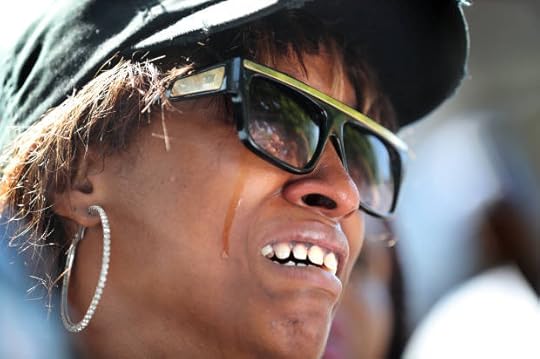
Diamond Reynolds, the girlfriend of Philando Castile, weeps during a press conference at the Governor'sResidence in St. Paul, Minn., Thursday, July 7, 2016. Philando Castile was shot in a car Wednesday night by police in the St. Paul suburb of Falcon Heights. Police have said the incident began when an officer initiated a traffic stop in suburban Falcon Heights but have not further explained what led to the shooting. (Leila Navidi/Star Tribune via AP)
This article originally appeared on AlterNet.
Millions watched the video Diamond Reynolds livestreamed of her boyfriend, Philando Castile, bleeding in the driver’s seat of his car after being shot by a police officer. One of the most stunning features of the 10-minute video is just how composed she stays throughout the filming, even as the police officer kept his gun pointed toward the car that contained herself and her four-year-old daughter.
“Ma’am, keep your hands where they are,” one officer says to Reynolds.
“I will sir, no worries, I will,” Reynolds responds, before calmly explaining to the Facebook livestream viewers that the cop “just shot his arm off.” It’s not until several minutes later, sitting in the back of a police car, that Reynolds finally breaks down.
“I can’t believe they just did this I’m—,” Reynolds says before letting out a scream.
“It’s okay, I’m right here with you,” her daughter, sitting calmly beside her in the cop car, replies.
Speaking to reporters Thursday, Reynolds said her daughter gave her the strength to remain calm, even as the same police officer who shot her boyfriend frantically cursed while his gun was pointed at the victim’s bleeding body.
“My daughter told me stay strong, and that’s what I had to do,” Reynolds said. “My daughter told me, don’t cry, and that’s what I had to do. My daughter prayed for me.”
One trauma expert told the Washington Post Reynolds’ behavior exhibited “the brain on horror.”
“People are literally not feeling in their body what’s going on,” Harvard Medical School psychology professor Jim Hopper said. “That circuitry can basically shut down.”
Monnica Williams, director of the Center for Mental Health Disparities at the University of Louisville and an expert on the brain, said Reynolds’ reaction could also have been informed by a fear of police.
“This becomes something that you might even expect,” Williams said. “All you have to do is turn on the television and see another black man has been shot.”
“Being able to stay calm in a crisis — you preserve your life and protect your loved ones,” Williams added.
Reynolds’ dedication to recording the aftermath and broadcasting it to the world may have also kept her calm by allowing her to focus on something other than the immediate crisis at hand, Hopper said.
“She’s grasping for dear life to these phrases, to this phone,” Hopper said. “You can think of it as a life raft to try to get through this.”
Reynolds herself alluded to Hopper’s point. Speaking to reporters, she said her motivation behind filming the aftermath of the shooting was that she “wanted it to go viral so the people could see.”
“I wanted the people to determine who was right and who was wrong,” she said. “They took my lifeline. That was my best friend.”
July 8, 2016
How Matt McGorry falls in love: “When I do, I’m all in”
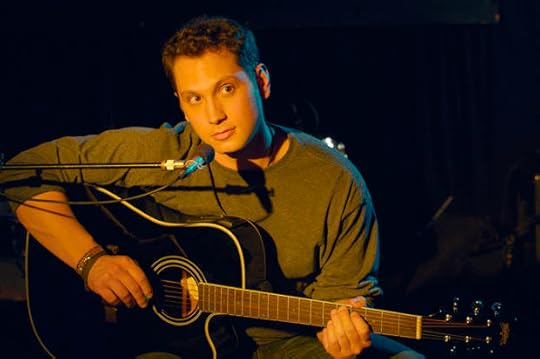
Matt McGorry in "How He Fell in Love"
Matt McGorry, former bodybuilder and current actor/feminist/activist/heartthrob, gets a juicy leading man part as Travis, the “He” in writer/director Marc Meyers’ “How He Fell in Love.”
In the film Travis is a struggling musician who attends his ex’s wedding without his girlfriend Monica (Britne Oldford) in tow. On the way back home, he shares a ride with Ellen (Amy Hargreaves), an older, married woman, with whom he soon begins an affair. How the two lovers navigate their lives and relationships forms the crux of this intimate, affecting drama.
McGorry’s Travis is described in the film by a friend as being “charming, comforting to people,” and in our discussion, McGorry is as well. The actor, who came to prominence with TV roles on “Orange Is the New Black” and “How to Get Away with Murder,” has an affable, winsome quality to him, one that was on display throughout our interview.
Travis, however, is in a rough place both professionally and personally. His emotional situation may be ameliorated by his passionate affair with Ellen. But, then again, maybe not.
McGorry chatted with Salon about his thoughts about relationships and making “How He Fell in Love.”
What can you say about your experiences with love? Are you easily smitten or are you choosy?
I don’t easily fall in love. With my friends, I prioritize a strong connection over a lot of connections with different people. I’m the same way with love. It’s hard for me to find something that excites me, but when I do, I’m all in.
There’s the website, “Wait But Why,” and they do incredible articles. Tim Urban did one on dating and finding your life partner, and he breaks it down in an objective way. People’s views of love tend not to be that objective. When online dating was a new thing, people thought it was weird to say they met online, but now it’s trendy. Consider that versus the traditional ideas of marriage that were more transactions. TV and film portray a large role in our perception of love, and if there is something to be said about that, it’s that it is portrayed as a bit more simplistic than it actually is. One of the important takeaways from that article, which rings true for me, is that people typically view being in a relationship as better than being single. At the bottom of the hierarchy is being with the wrong person, then being single, then being with the right person. I would agree with that. There are a lot of notions of love that are oversimplified. Love is a lot of work. Love, someone said, is never asking someone to change.
Would you attend or have you attended an ex’s wedding?
Yeah, I would. One of my long-term exes is one of my closest friends. If I were feeling the way Travis was feeling, I wouldn’t do it. It didn’t seem healthy for him; there was an underlying agenda that he would get validation or closure, which is not appropriate. It’s unclear in his relationship with Monica as to whether or not they are exclusive. There is a different set of expectations for the both of them. As humans, we get in these situations where one person wants something we’re not ready to give, but we keep doing it. He rethinks that relationship with Monica. He’s in a place of emotional shutdown. And I love that Monica calls him on his shit. You don’t want to change the fundamental character of a person you’re dating, but there’s a compromise and you figure out where you can and can’t. It’s not going to be the first six months of a relationship forever.
Travis is a musician. Are you a singer/performer?
I am not, actually. I feel I’m weirdly the antithesis. I always thought I could never play a musician. I don’t think I look like what musicians look like. I’ve never taken any instrument lessons, but both my brothers are musicians. This [role] was my first real foray into it. I understand why people would like it.
Travis says the band was his life, but he doesn’t have that anymore. How do you “change things up?”
In the world of acting, I think there are people at certain levels who have a full breadth of choice. Like Leonardo DiCaprio. Anyone below that, oftentimes, it’s not “I want to do this now…” It’s been important to challenge myself in new ways and see what I can do. Bodybuilding and lifting was about challenging my discipline and my ability to commit to something that frankly many people in my life don’t care about, but it was important to me. That’s been an important lesson for me. When I put bodybuilding and lifting behind me to pursue acting, it gave me a sense of autonomy. Learning about the science of training, how to eat and train for objective results, is something I applied to my acting career as I got that off the ground.
Do you feel pressure as the lead in an indie film? That this role is a break-out opportunity, a chance to prove yourself as an actor?
There was some pressure. I am good at tricking myself into forgetting about the high-stakes situations in a very functional way. Even the same way when I started on “Orange,” I was stressed out to do the best I could do with the character and scripts, and I realized that was not a great recipe for me to do my most relaxed work. So I worked on not putting that pressure on myself. I was able to do that in the atmosphere Marc Meyers created. That was helpful as well. He was open to my improvisation and ideas and we were more collaborating and creating something in terms of what I could bring to it as well. That made me feel good about it. We had a similar style of working. I gave a variety of takes and let him piece the story together in the editing.
Travis seeks Ellen out in her yoga class. Do you do yoga?
I don’t do yoga. I’m hyper-mobile and my joints are too lax, so it doesn’t behoove me to do much flexibility work. Stretching out more is not good for me. I enjoyed yoga in the past, but from a workout perspective, it doesn’t do it for me, but I do Transcendental Meditation (TM) every day. You’re supposed to do it twice a day, but I do it only once. It’s not having moments of profound awakening, but it frees up my mind and allows me clearer thought. I was into meditation before TM, but it was hard for me. TM was said to be very simple and easy and I found that to be the case. The point is to do it, not be perfect at it. Historically, I have tried to do things perfectly, and that’s not the way to live a happy life.
What is your response to your heartthrob status?
It’s nice. [Laughs] I think that there’s a lot about celebrity culture and social media culture that really can go different ways very quickly. The role on “Orange” was a likeable character, especially in a world where the men were not particularly likeable. It was written “romantic,” so that played a factor—if people like to think of me that way. On “How to Get Away with Murder,” I’m less of a romantic character. It does change people’s perceptions.
For me, it makes sense to examine and remember to build that confidence internally, and rely less on the external. I’m new to being a public figure, and I’ve relied on external validation in my life—more than I would like—and when “Orange” came out and social media increased, it was validating, but not in a way that one should bank on. Acting can be a fickle career. It could disappear tomorrow; but I hope it won’t. I tried to prepare myself for that outcome. How do you not rely on that external feedback in the age of social media? Everything we do, we feel we haven’t done it unless we post it on social media, and get likes, and we get a chemical response in our bodies when that happens. That’s great, and I’m grateful for fans and platforms, but it’s good to remind myself on how to validate myself. That can be tricky.
Why do you think Ellen and Travis are attracted to one another? What do you think they see in each other?
It’s hard to say exactly. She represents—despite her situation—a safety, a certain level of caring. She seems very forthright and trustworthy, which he values. As with all things in love, it’s hard to pinpoint the defining characteristic. But from the outside, you wonder how do these people work?
There is something to be said for the fact that these people come together in imperfect times, and have an experience…
How did you and Amy develop your on-screen rapport?
We auditioned together; she had the role. There was a chemistry that you can have with some people and not others. It’s hard to define. We had trust from each other. The scenes called for intimacy in the audition, and in that process I made sure things were OK for her, and that made her feel comfortable and that she could trust me. We had respect for each other as performers and people.
I got out of a relationship recently, so there were aspects of that were fresh for me. It’s hard to describe the process. It’s dynamic and fluid.
Who do you think has control in the Ellen-Travis relationship?
That’s the fluidity of it as well; that’s the complexity. We don’t see the same dynamic play out. With Ellen and her husband (Mark Blum), she has the power. With Travis and Monica, he has the power. But with Ellen and Travis, there’s an ebb and flow. It’s based in circumstances, and love doesn’t exist outside of external circumstance. We can’t get around things. I talk to friends, and it’s “I really like him/her but can’t get around this one thing…” People talk about these circumstances like they are a tumor that can be snipped away.
You have self-identified as a feminist. Have you taken on projects that align with your beliefs?
I think I’ve been fortunate that many of the projects line up with my belief. Starting out, I would have taken any project, even if my character were on the problematic end of the scale. But [my outlook] definitely influences my choices, but I won’t say I wouldn’t choose a character because of [their politics]. That is not the only factor. I don’t think it can be. It’s great when it happens, though.
Travis is weighed down by guilt. How do you cope with responsibility?
It’s a complicated issue. I see that a in lot in people and friends of mine, this sense of a weight of past things. It’s important to realize mistakes, and part of realizing it is how we effect change in the future. Travis may not have done anything wrong. I’ve had that feeling in my life, and I want to assign responsibility to myself even to things beyond my responsibility. I sometimes take on too much, and finding a healthy place to find responsibility for the past while not allowing it to paralyze you is important.
What observations do you have about relationships from what you have experienced in life, or even through making this film?
I think that it comes back to what we were saying before, about relationships that feel world-changing in the beginning but very quickly don’t take a turn. You can’t always know that will happen. The older you get and the more experience you have, the better you are at deciphering what makes the most sense. In general, it’s a good thing to be aware of past patterns. But if this is the fifth time Travis has been in a relationship with a married woman, then therapy could be helpful.
TV as a conservative safe space: Fragile viewers can’t handle being challenged by their entertainment
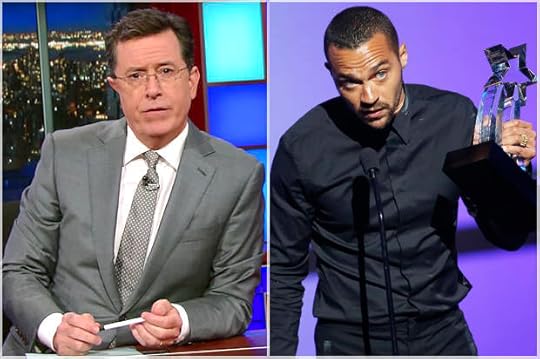
Stephen Colbert; Jesse Williams (Credit: CBS/Reuters/Danny Moloshok)
When “The Late Show with David Letterman” premiered 23 years ago, the television landscape was a very different place. Scott Sassa, former president of NBC West Coast, describes the era’s network programming decisions as tailored “towards something called ‘Least Objectionable Programming,’ which meant the show that would suck the least so people wouldn’t change the channel.” The introduction of carrier and subscription fees into television revenue models, driven by technological advances, has brought with it further choice and greater channel diversity. Which also offers comedians greater freedom with their products: they can be quirky, they can be self-referential, they can be weird. Where before they could only risk alienating minority audiences (in the general sense of the word) who suffered from limited options, they can now risk alienating larger segments of the population if it means building a brand, and inspiring greater loyalty amongst an admittedly smaller viewership base.
These sweeping developments are of no interest to Hans Fiene of The Federalist, who attributes the increasing politicization of late night comedy to one man and one man only: Jon Stewart. Fiene goes so far as to describe Stewart’s appearance on “Crossfire” in 2004 as “the day late-night comedy died.” According to Fiene, comedy with an agenda is not comedy at all, and is instead an entirely separate genre, one invented by Stewart’s viral takedown of CNN which sparked, in Fiene’s view, a cultural generation of mimics.
Needless to say, Fiene isn’t especially happy about the development. “[I]t’s one thing to build your own show,” he writes. “It’s another thing to take the comedic institutions built by actual comedians and turn them into platforms for advocacy-with-jokes… Stephen Colbert, for example, left his faux-conservative-blowhard persona behind at Comedy Central but kept the political posturing when he took over David Letterman’s chair on ‘The Late Show,’ and the result is a show that is not so much unwatchable as it is unrecognizable.”
Blatant ignorance of the history of comedy aside, I am somewhat sympathetic to the notion that a sense of community was lost with greater market segmentation. But I would be more sympathetic to said argument if Fiene seemed genuinely interested in cultivating that shared culture over values like true inclusion, welcoming into the fray groups that were left out of the mainstream comedy of yore, comedy that was sexist, racist and homophobic. Instead, his examples of perverting mainstream culture have nothing to do with political ideology, in the specific sense of the word. Instead he throws a hissy fit over the suggestion that queer, female, minority characters also deserve a place alongside straight, white, male ones in the franchises that have traditionally received institutional support. He encourages those who want to be seen in that culture to start their very own franchises from the ground up, again betraying a willful ignorance of the economics and history of entertainment, advocating for a culture that is more splintered, not less so.
In doing so, Fiene reveals that he is not truly interested in inclusive community. Instead, what he wants is closer to conservatives’ parodic characterization of liberal campus culture. He wants late-night comedy to be, for him, a “safe space.” Of course, he doesn’t describe his desires as such, because he has had the great fortune of feeling welcome and safe in the broader culture for the vast majority of his life.
And so Fiene confuses comedy that is appealing to his politics with comedy that is apolitical. And the error is not his alone. When Jesse Williams delivered a searing indictment of the state of American race relations during an acceptance speech at the BET Awards, he was met with a petition to get him fired as a cast member of Shonda Rhimes’s hit show “Grey’s Anatomy.” Those who launched and supported the petition, of course, knew nothing of Rhimes’s politics, and she immediately shut down the notion that he ought to be punished, rather than lauded, for his provocative poetry that evening. For Rhimes believes in truly inclusive entertainment, inherently diverse, which inherently leads to greater diversity of opinions on and off set. Those who’d see Williams fired don’t want the people on their television screens to be apolitical; they want them to have the politics that would allow them to remain silent in the face of systemic, racist exploitation and abuse.
Fiene falls into a similar trap when he criticizes Kate McKinnon of NBC’s “Saturday Night Live” for voicing her support for Hillary Clinton’s candidacy in a Hollywood Reporter interview, using her personal political beliefs as evidence that the show has become a promotional tool for the left. He neglects to mention that the comedic institution gave Donald Trump a platform to promote and glorify himself not five months after he was fired from NBC for racism. He praises Jimmy Fallon for his absurdist comedy, neglecting again to mention that he has welcomed Trump onto his show to do the same. “Pure comedy,” in Fiene’s view, is that which further normalizes forces which have always been normalized in American society; it is that which silences minority voices.
Straight white men condoning racism is inclusive comedy, you see, but straight white men who make the occasional funny about an overtly racist presidential candidate is a bridge too far. Thank God our brightest comedic minds don’t see it that way. They recognize what Fiene does not: If the right didn’t want to have to hear jokes at its expense, it shouldn’t have nominated a walking punch line.
“To break the shackles of gravity”: How women’s gymnastics captures our imagination every 4 years
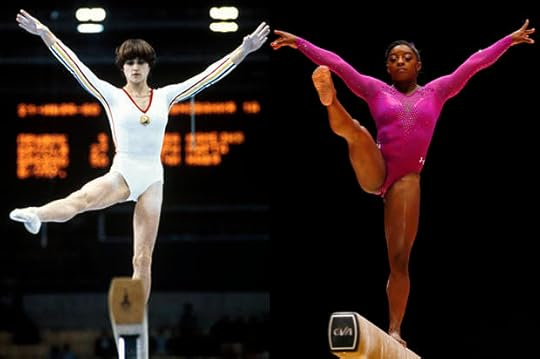
Nadia Comaneci, 1980; Simone Biles, 2015. (Credit: AP/Matthias Schrader/Photo montage by Salon)
Dvora Meyers’ impressive and fascinating debut “The End of the Perfect 10” lands just in time for the this year’s Olympics. The 33-year-old Brooklynite and former gymnast became obsessed with the sport when she was 6. Gymnastics and break-dancing were unlikely pastimes for a nerdy Orthodox Jewish girl, perhaps why she dedicates the book to her mother, for driving her to practice early every Sunday morning. That dedication paid off, not with medals but with a winning story about women like her, who were empowered by athletics.
Meyers, who covered the Olympics for Jezebel and Deadspin, explores the crucial time after Nadia Comaneci was the first to receive a perfect 10, the post-modern gymnastics world, and how this changes the sport’s international landscape. In the post-Comaneci era, the women’s sport is less focused on art and perfection, and more on athleticism and strength.
The first of its kind, “The End of the Perfect 10″ contextualizes Olympic gymnastics, taking it beyond the marginalized category of “women’s sport” to its deeper political relevance.
Salon spoke with Meyers about how women have shaped gymnastics and why she fell in love with the sport.
Though gymnastics is one of the most popular Olympic sports, there’s little serious analytic reporting on it. Why?
I’ve often wondered why it hasn’t been taken seriously. I think because first of all it’s an Olympic sport, so it doesn’t, at least to outsiders, have this annual season and cycle. It’s something you pay attention to once every four years. Therefore the majority of sports writers and people writing about it for the Olympics may have only a passing knowledge.
I think what ends up happening is that you recycle the same stories of who’s big this year, who’s the new champion. It’s sometimes hard for people to get past that if they’re only paying attention to the sport once every four years, or even just once a year during a major competition, as opposed to really following it closely the way other sports, like football and baseball, are followed throughout the year.
I would also say that to some degree, it is a sport identified primarily with women. As a result, at least historically, that also gets trivialized. Then add the fact that the main practitioners of gymnastics are very young women, another group that may not get taken as seriously.
How does this shape the narrative of gymnastics?
It certainly shapes the narrative in that it’s seen as an Olympic sport. Earlier this year, when the UCLA gymnast Sophina DeJesus’s floor routine went viral, the majority of the articles about her stressed whether or not she had wanted to go to the Olympics, even though the NCAA has been around for a very long time, and it has its own competitions, set of rules, and priorities. It’s a head-scratcher, because they really don’t have much to do with one another, but that’s because people generally understand gymnastics through the prism of the Olympics.
What effect did changing the scoring system have on the sport?
One of the problems of the 10 is that often, because of the normal impulse to push boundaries, athletes took higher risks than they needed to, and weren’t being rewarded for it. The scoring approach is catching up to what athletes are doing. It’s interesting because if you look at Nadia in 1976, and Olga Korbut in ’72, in many respects the rules lagged behind the athletes. It was the athletes driving the rules forward.
With the new scoring system, a lot of people feel that instead of the athletes putting pressure on the rules to change, and the creative impulsive coming out of the athletes and the coaches, it’s the rules putting pressure on the athletes to see that sort of flip.
Nadia did more than she needed to do, certainly, to win. There were few requirements when she was competing. Back then, there was this feeling that if you could do a little more, you should, because it will make you stand out. Even though she didn’t have to, she went for it anyway. In that respect, she and her coaches were pushing the sport forward. They had caught up to whatever the rules were and they went beyond that point.
There’s this impulse in high-level athletes to push the envelope as much as they can.
Do you think gymnasts will eventually reach a limit to what the human body can do?
I do think there is a limit. Will we see more difficult dismounts off the balance beam? One Olympic gymnast said to me, “I guess if you made the balance beam a little wider you could launch off of it with more power.” Some changes will depend on if there are any improvements to the equipment, and there have been a lot of developments over the years: springs in the balance beam, springs in the floor.
Many of the advancements in skills have come from a better understanding of training methods and injury prevention — though we still have a lot of injury. If there are more improvements in preparation methods you’d see some increases in difficulties.
Something I took away from speaking with Simone Biles is, even though she’s unique since she can do these mind-blowing skills, a lot of gymnasts do things in their gyms they’re never going to compete with. I hesitate to say we’re at the edge because I know that in training bases gymnasts are experimenting with more difficult skills.
Can gymnastics be enjoyed purely at an aesthetic level?
There are different levels of enjoyment. I would never say that it couldn’t, but I do think a lot of people are fascinated by gymnastics and are curious to know more than they’re getting from the typical TV coverage, which is not geared for that type of analysis.
That makes sense. Even as a former gymnast, I still wonder if I’m missing the real significance of the routines because I don’t know what it takes to do these tricks.
This is something I thought about because I’ve always wondered why some sports are more relatable than others. Gymnastics is one of those sports that’s not particularly relatable to the average viewer. With other sports, the difference between me to the professional is a matter of degree.
But most people have never done flips. So it’s not a matter of degree that separates the viewer — it’s on a whole different plane. That’s what makes it difficult for the average viewer to understand. When we watch other popular sports, they incorporate movements we all do.
Even a low-level participant of gymnastics who knows a lot still can’t fathom what that upper level looks like; we all struggle to understand that. There’s an element of the metaphysical — flying, and the desire to fly.
What appeals to me is that desire, to break the shackles of gravity, and how most of us never do it. Most of us never get close.
“It is deeper than sadness”: Thousands mourn at vigil for slain police officers in Dallas
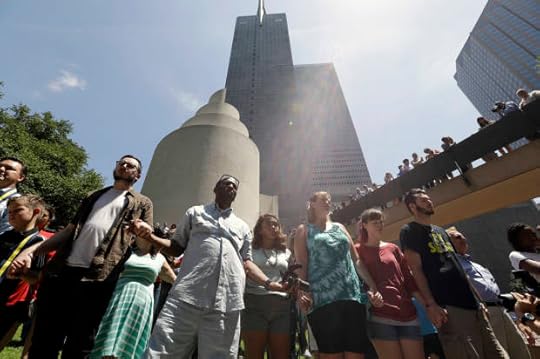
People join hands as they take part in a prayer vigil at Thanksgiving Square, Friday in Dallas. (Credit: AP)
Thursday night, Willie Range was watching TV at home in Oak Cliff, just a couple miles from downtown Dallas. Range, the chaplain of the Dallas Fire Department, saw a report that an officer had been shot. He immediately walked out his door, got into his car, and drove to Parkland Hospital, where several of the victims were being taken.
Over the next few hours, Range had the burden of telling two families that their loved ones — police officers — had been shot and killed by snipers in downtown Dallas.
The only way he can describe those moments: “Pandemonium.”
Range attended a prayer vigil at Thanks-giving Square on Friday afternoon, just a few blocks from where the pandemonium originated.
Among the attendees during Friday’s vigil were police officers, first responders, Dallas’ and Texas’ top politicians, reporters, residents, and a newly formed interfaith coalition.
The sound of the helicopters flying overhead drowned out most of the notes of “Amazing Grace” being played by a band and many of the remarks and prayers from the speakers. The temperature climbed past 90, and Range was joined by an ever-growing crowd. Among the sea of news cameras and bodies were those who had been working the peaceful protest, which was followed by shooters targeting police officers. The officers’ long day finally ended in the early morning hours when the department sent a robot in to detonate an explosive, killing the gunman, 25-year-old Micah Xavier Johnson. So far, four Dallas Police officers and one DART officer were killed and seven other officers and two civilians were wounded.
For the city of Dallas, the past 15 hours had been filled with tense moments. For the crowd gathered at Thanks-giving Square, this one hour was a time to pause, reflect and mourn.
One of the first speakers was Dallas Police Chief David Brown, who has faced a great deal of criticism this year. The Dallas police force morale has been low, and many new recruits have left to take jobs in neighboring communities with better pay. But none of that showed when he stepped up to the mic.
“In the police profession, we’re very comfortable with not hearing thank you,” he said, but was then interrupted by a chorus of “thank yous” from thousands of people gathered around him. “So, today feels like a different day. Dallas is a city that loves. We’re hurting, and we need this community.”
Tanya Ragan, a downtown Dallas resident and local-business owner, was among the crowd. Over the past few years, Ragan has collaborated with the police department in her work growing downtown Dallas from a commercial center to residential neighborhood. “In the last several years, we’ve experienced a lot of growth, and during that time, we have relied so heavily on our police in transitioning to an urban city,” she said. “With that growth has come a really, really close relationship with the police. We really consider the police our family.”
Like most people in the audience, Ragan had only received a couple of hours of sleep as she worked through the night to calm neighbors’ fears and check in on friends. “These officers were out at a friendly protest, protecting our citizens, and they’re attacked from behind and targeted. It’s really difficult to even get your mind around how that is possible,” she said.
Reverend T.D. Jakes echoed the feeling of sleeplessness that he received the previous night. He sent a text to a friend at 2:30 am saying he couldn’t go to bed. “But then I realized, ‘They were sleepless in Ferguson. They were sleepless in Baltimore. They were sleepless in Milwaukee,’” he said. “We don’t recognize pain until it’s on our front yard. The tragedy we ignore today will be on our doorstep tomorrow.”
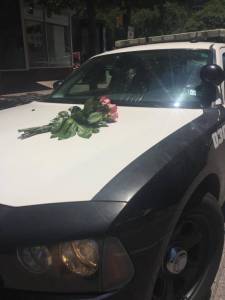
Photo Credit: Krista Nightengale
Mayor Mike Rawlings took part of the blame for our country’s current poor racial relations. “This is on my generation of leaders,” he said. “We have led the next generation down a path of rhetoric that has pitted one another against each other.”
From on top of a hill, Joli Angel Robinson, tried to listen in, as helicopters drowned out many of the remarks. She was standing among her colleagues on the Dallas Police Department. Robinson, the manager in the Office of Community Affairs for the Dallas Police Department, said that as a black female, she has had a grief-filled past few days.
“So the Dallas Police Department officers being shot and killed and injured just amplified the feeling of sadness and grief,” she said.
Robinson’s office is on the second floor of the Jack Evans Headquarters. She left the vigil and went back to her office to answer calls. From her window, she watched the memorial in front of the headquarters grow. She said she’s spent time crying. She’s been angry. And there have been a few cuss words. She had yet to hear the names of all those killed and injured. When asked how that made her feel, she went silent, and her eyes welled up with tears. “It is deeper than sadness,” she said.
The No. 1 question she’s received today: What’s next for Dallas?
Ragan, who’s been working with city staff and the police department, asks that people not plan any more gatherings. Gatherings require resources from an already-taxed group of people. She recommends donating to organizations, such as Assist the Officer Foundation.
Back at the vigil, as the crowd left, a passerby placed a bouquet of roses on a running police car. Across the street, a police officer gave an interview to a local news station. Tears ran down her eyes. The reporter stopped, and they hugged. Next door, local restaurant, Café Izmir, offered free lunch to all officers. Down the street, a small crowd gathered to honor their fallen brethren. And at Jack Evans Headquarters, Robinson watched the memorial grow even bigger.
“We need to deal with some things that have been festering within our society that we have been trying to avoid,” she said. “Poor race relations are real. That’s not just black and white. That’s not just Hispanic. That’s not just majority and minority. That is a culture of a variety of people from various backgrounds. We have to learn how to get along here on this one planet Earth that we’ve been given. That is how people can help moving forward.”
Child marriage is finally illegal in Virginia — and other states may be on their way
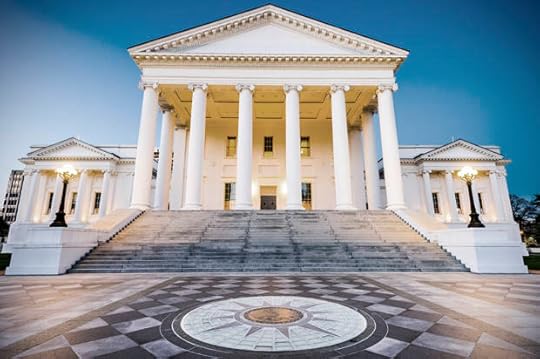
(Credit: Sean Pavone via Shutterstock)
Bad news if you’d like to marry a child in the state of Virginia — as of this month, children under the age of 16 can no longer get hitched.
In case you thought that child marriage was a relic of bygone eras or an abusive practice that happens in other places, before July 1, 16- and 17-year-olds could marry with parental consent — and children even younger could wed with parental consent if the girl was pregnant. Relatedly, Virginia is one of the 37 states the mandate that its sex education curriculum include abstinence education. And according to the National Campaign to Prevent Teen and Unplanned Pregnancy, nearly 5,000 Virginia teenagers became new moms in 2014.
In a conversation with William & Mary News this week, Vivian Hamilton, a professor at the school who worked on raising the state’s marriage age, explained that “The new law does away with the most troubling, youngest marriages. By putting procedural safeguards in the way of 16- and 17-year-olds seeking to marry, we hope it will drastically reduce the occurrence of minors being coerced to marry.”
And to prove that that’s something that badly needed to happen, Hamilton went on to state that “In Virginia alone, almost 4,500 minors under age 18 were married between 2004 and 2013. Some 90 percent of minor spouses in Virginia were girls, and many of them married men significantly older than they were — sometimes decades older…. [The previous law] allowed abusers who could otherwise be prosecuted for statutory rape to evade prosecution by marrying their victims.”
The UK’s Independent reports that among the 4,500 girls under 18 who married in that time, “more than 200 of them were aged 15 or under.” As Virginia Sen. Jill Vogel told WTOP back in March, “Someone… should be asking the question, ‘Well if this 13-year-old is pregnant, isn’t that evidence of statutory rape?’ Is that not a crime?” Vogel told the Washington Post this week of just such a case — a man in his fifties she says avoided Child Protective Services by persuading the parents of the high school student he was suspected of sexually abusing to consent to him marrying her. “Now they’re married, and there’s no crime,” she said. “She dropped out of high school. Her life is ruined.”
The encouraging news is that these kinds of grim stories are now going to become less common — and not just in Virginia. The National Conference of State Legislatures says that similar bills have also been introduced this year in California, Maryland, New Jersey and New York. Yet right now matrimonial ages vary from state to state but skew preciously young — California currently has no minimum age for marriage with parental consent. In New York, the minimum age with parental consent is 14. And in New Hampshire, a bride can be as young as 13 (though her husband to be must be 14 or over). THIRTEEN.
In other words, there are plenty of places all across the country where a girl’s parents can sign off for her to become a wife before she’s even had her first period. Before she’s even finished with middle school. Before she can vote. Or drive. Or obtain working papers. The economic, educational and emotional consequences are long term and often devastating.
But not everyone agrees that limiting these unions is a good idea. Sen. J. Chapman ‘Chap’ Petersen told the Washington Post this week that “Maybe I’m old-fashioned, but if someone gets pregnant and they want to be married when the child is born, not being able to do that of their own volition without going to court, I thought that was a little bit overly aggressive.” Yeah, I guess you could call encouraging girls to become wives and mothers while they’re still children themselves than “old-fashioned.” And as Del. Jennifer L. McClellan explains, “Sex with a child is illegal, but the way the marriage laws worked, if you were under 16 and pregnant, rather than punishing your assailant, you were allowed to marry them.”
Lingering questions over death of black man found hanging from tree in Atlanta park

Piedmont Park, in Atlanta, Georgia (Credit: Wikimedia Commons/Daniel Mayer)
The FBI is investigating the death of a black man who was found dead hanging from a tree in Atlanta early on Thursday morning.
Police say the death was likely a suicide, but some people have speculated it could have been a lynching.
The police report released Friday, according to The Atlanta Journal-Constitution, suggests the hanging was a suicide, but leaves questions.
While hanging from the tree, the man had a backpack around his waist and earbuds in his ears, according to the report.
Police said he “appeared to be clean cut and well dressed.”
The report also noted that the man had marks on the front of his pants and light pollen on the front of his shirt, which suggests he could have climbed the tree.
Next to the tree was a large garbage can with shoe prints on the top. Police said the shoe prints looked fresh and were the same pattern as the shoes the man had on.
Atlanta police spokesman Donald Hannah there “were no discernible signs of a struggle or foul play.”
Hannah noted that a medical examiner in Atlanta’s Fulton County had agreed that the death “was consistent with a suicide.”
Activists and people on social media, however, speculated that the hanging might have been a lynching. The hashtag #PiedmontParkHanging was trending on Twitter on Thursday night.
#PiedmontParkHanging y'all are telling me a black man in the south went to a park to commit suicide by hanging? Nah, I'm not going for it.
— Jaeda (@jaebenzo_) July 7, 2016
Why on earth would a black man hang himself in a PUBLIC area?? To argue that this was a suicide is asinine #PiedmontParkHanging
— Luke Cripwalker (@sporker_) July 7, 2016
A white man found dead = full investigation! A black man found hanging from a tree = no investigation! He hung himself! #PiedmontParkHanging
— nick washington (@girlsugar) July 7, 2016
Some people claimed that the Ku Klux Klan had been hanging out fliers in the park.
The KKK passed out flyers last night at Piedmont Park & the next day we wake up to a black man hung at Piedmont Park #PiedmontParkHanging
— Ijeoma (@Dr_Abuajah) July 7, 2016
I don't believe for a second that a black man would hang himself with a rope from a tree where the KKK was active. #PiedmontParkHanging
— baby (@crybabygav) July 7, 2016
Police could not confirm to local media if the KKK had been in the area the night before the man’s death.
Police spokesperson Lukasz Sajdak said “there is no information on the KKK being in or around the park.”
The hanging came at a time of outrage at police killings of black Americans. Earlier this week, the brutal police shootings of Philando Castile and Alton Sterling were captured on video. Footage of these attacks have circulated widely on the internet.
On Thursday night, a sniper in Dallas reportedly shot five police and injured seven more. The suspected shooter was a U.S. Army veteran who wanted to kill white police officers in revenge for police killings of black Americans, police said.
The identity of the man found hanging in the park has not yet been released. According to police, he had no forms of identification on him, local media reported.
Atlanta Mayor Kasim Reed said he is “deeply saddened by the loss of a young man’s life.” He called the incident “disturbing” and said he ordered “a robust investigation.” On Thursday he announced the case had been referred to the FBI.
“Everything we have seen suggests that there was no foul play involved, but I want to state clearly and unequivocally that we will not prejudge the circumstances surrounding this young man’s death,” Reed added.
Racial injustice, anger and the power of visibility: “In order to have change, things have to get worse”
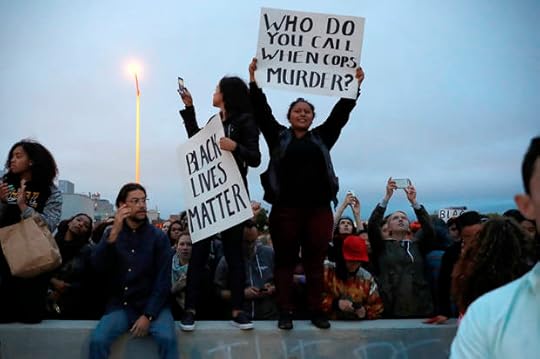
Demonstrators in Oakland, California, July 7, 2016. (Credit: Reuters/Stephen Lam)
The past week has been a violent and rancorous one, with accusations flying back and forth between politicians and activists. How much of this is coming from partisanship and hatred simmering in the country, and how much from a few violence individuals? And does it seem to be getting worse?
Salon spoke to Carla Shedd, an assistant professor of sociology at Columbia University. Shedd, the author of “Unequal City: Race, Schools, and Perceptions of Injustice,” writes about adolescence, urban institutions, and the justice system.
We spoke to Shedd from her office in New York City; the interview has been lightly edited for clarity.
Let’s look at the big picture first. Over the last few months, there has been violence and threats and tension at political rallies held by both parties. There have been more shootings by police of black men this week, adding to a crisis that goes back years now. Police officers were shot in Dallas yesterday, with five of them killed. There’s anger in every aspect of American life right now, and you can see it on Twitter and social media.
Do we seem to be entering the kind of period we were in in the 1960s, with major waves of urban violence? Does it feel like the country is boiling over?
I think it’s right to harken back to the riots and uprisings of the ‘60s, and look at discrimination and racism as being very prominent and very visible. But I think there are cycles we’re seen, beyond the ‘60s, where things have gotten worse, and then better, in this awful cycle or inequality and injustice coming to the forefront. We have advancement, and then here we are back again. Derrick Bell, the late law professor, talked about that.
What direction does it seem to be moving now?
I think in order to have change, things have to get worse. Things have to bubble up and bubble over. As a scholar of race, I’m actually heartened by this opportunity to put everything out in the open – to think about injustice. If we can confront it, we might be able to do something about it. If we can’t ignore it any longer.
That’s what I think this moment is – the crystallization of disparities across race and class and place that can no longer be ignored because of their visibility, and people being plain about what they feel, what they experience, and how they view other people.
You think there’s something healthy, as rough as this is to watch day by day, since we’re confronting existing problems.
Right.
The relationship between black people and the police is something you’re written a lot about. The relationship has been strained for a long time. The recent killings surely haven’t improved things. How much tension and frustration exist now?
I would characterize it as an institutional betrayal in the way black people feel about the police. This is an institution set up to serve and protect, and there are communities that feel that they don’t get that type of service. Instead, they feel surveilled and punished and controlled instead of served and protected. I think that’s the root of the difference. It’s an institutional failure by police in their central mission to protect and serve the public. So black people don’t see themselves as part of that public that is worthy of protection and worthy of respect. And the reason is they perceive an unequal distribution of justice.
My work has been about tracking and documenting young people in particular in their perceptions of injustice by police and other people in positions of authority.
How do generational differences work out here?
I just read a Twitter post by John Lewis, Congressman John Lewis, civil-rights pioneer. He said, “I was beaten by police officers, but I never hated them. I said, ‘Thank you for your service.’ “
In his generation, there was this note that, “If we’re respectable, if we comply, if we show them how great we are, they will see we’re worthy of respect and protection.” He’s trying to morally compel them to see him as a full person.
The new generation – they’re not swayed by that. They can see that does not work. It doesn’t matter what you wear, you can still be stopped and frisked by the police, you can still be compliant and still be killed. This generation sees, This doesn’t work.
Let’s close by talking about the effect this has on children. It’s bruising for everyone to see violence, but it’s especially rough on children. What kind of effect does it have on them, and what’s the right response for parents trying to keep kids informed as to how the world works but also trying to keep them psychologically whole.
We all are grappling with this. I’m the mother of two children, one boy, myself. How do you socialize your children to understand authority, how do you prepare them to be compliant but also not feel that they have to be subject to someone’s dominion and control? It’s a pretty delicate balance.
I think the young people seeing these videos, these horrible news covers and headlines – they are experiencing trauma. And they’re gonna have to figure out – if they’re 10, 11, 12 – that they may be children in the eyes of their parents, but in the eyes of police, they could be seen as suspects of potential criminals, if we think about Tamir Rice being only 12, and what happened to him.
So I think it’s those kids, at the vulnerable space of trying to figure out who they are, also trying to figure out how the world around them views them. They’re the ones we’ll have to talk to and prepare, for reconciling all the messages of “You are a great person, but other people may not see this beautiful side of you.” That’s a pretty big gulf to bridge….
I hope that parents can make it clear that these are authority figures, who we have to show respect to – whether they’re teachers or police on the street — but also keep intact that child’s humanity, that sense of who they are.
At the extreme end of the trauma – that little girl who witnessed the killings in the back seat – that just hurt my heart. She’s going to need to be supported, by counseling and other things. But it will hit young people especially deeply, as they try to figure out themselves and reconcile that with how the world sees them.
How to be a white ally: Fighting racism is your responsibility — start now
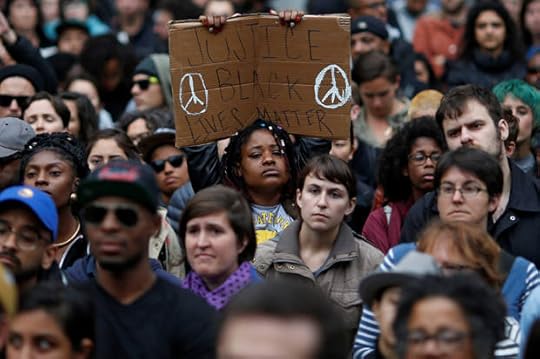
(Credit: Reuters/Stephen Lam)
In his powerful acceptance speech for BET’s Humanitarian Award this June, “Grey’s Anatomy” actor and activist Jesse Williams made a brief sidenote, reminding white people that “the burden of the brutalized is not to comfort the bystander.” This was less than two weeks before the addition of two more black men, Alton Sterling and Philando Castile, to the continuously growing list of POC killed by police. As we process the news of these most recent tragedies, Williams’s words help shape what our role—as white allies—needs to be in taking supportive action toward long-overdue change.
According to The Guardian’s The Counted, Sterling and Castile’s deaths bring this year’s fatal encounters by police officers in the United States to 556 — a disproportionate number of those victims, per capita, are black. This week, we’ve watched a son grieve his dead father and heard a mother recount how, in the moments after her boyfriend was shot during a traffic stop, she was comforted by her brave and empathetic four-year-old daughter. Whether you find yourself awash in fresh outrage or feeling despondent and numb, our responsibility to the black community is to act.
Here’s a list of practical, actionable suggestions. Start right now:
1. Have difficult conversations with people you care about—and with ones you don’t
That one uncle who “means well” but tells a racist joke at a family get-together. Your old friend from high school you haven’t talked to in years but lately is really into posting #AllLivesMatter memes on Facebook. A casual acquaintance you grab happy-hour beers with. The co-worker who sits on the other side of your desk. Start calling them out.
Yes, that means conversations will probably get awkward. Do it anyway. And when you can, choose to engage in discourse that moves discussions forward even when it would be easier or would feel more satisfying to shut down, to become belligerent, to write someone off, or to feel tired. (This is something black people are 100 percent not beholden to do any longer, by the way—this job is solely ours.)
Need guidance for what it means to “collect your people?” Read this.
2. Check yourself
Our racism is indoctrinated and systemic. Even if we’re actively fighting against the racism of our families, friends, and peers, we continue to benefit from centuries of oppression. No ally is immune from exhibiting racist behaviors or from being unhelpful even when their intentions are the opposite. Be willing to listen openly. Refrain from centering yourself in a movement that deserves your support but is not about you and about which you are not an authority. If you’re doing work as an ally as a means of earning capital to counterbalance your white guilt or as a way of seeking accolades for how not racist you are, stop taking up space at the table.
3. Participate
Show up (without steamrolling) at a protest or rally. Can’t do that? Donate instead — money, protest supplies, food and water, time or talent — there are many ways to help. Search for a local #BlackLivesMatter chapter in your city or take a look at this list of black-led social justice organizations if you’re wondering where to donate.
Research the platforms of local politicians and their records on policy reform for eradicating police violence, including support of body cameras, the creation of training programs to reduce racial profiling, and efforts to get crimes that disproportionately target POC and other marginalized communities off the books. Share your concerns if politicians aren’t taking real strides toward curbing hair-trigger violence and excessive use of force, especially toward POC, and withhold your support and your votes until they do. No idea who your elected officials are or how to contact them? Use .
Zak Cheney Rice details more ideas here about how we can help quell police brutality in our cities.
4. Bear witness
Download the ACLU’s mobile justice app or similar tools and prepare to record police interactions if you find yourself witnessing an encounter. Know the law and rehearse what to say if an officer asks you to turn off the camera. If you see POC being harassed by law enforcement, stick around. It may be illegal to interfere, but you’re allowed to remain present and keep watch over a situation where abuse of power may be taking place.
Absolutely none of this comes close to enough, but it’s a demonstrable way to be an ally in the face of hand-wringing that unfortunately sometimes stands in for meaningful action. We can’t take back the unnecessary deaths of Sterling and Castile or the devastating collection of names that came before them, but we must help keep that list from growing any longer.
The vicious dialectic of violence and retaliation: A plea for dialogue and peace after Dallas
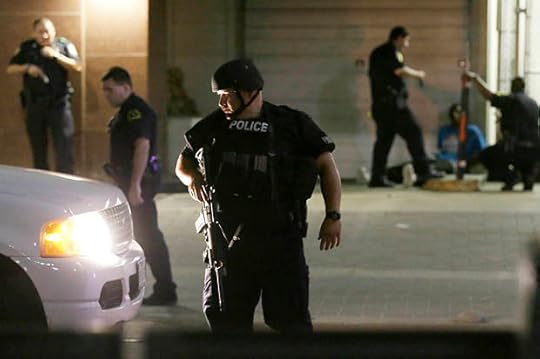
Dallas police, July 7, 2016. (Credit: AP/LM Otero)
Five Dallas police offers were killed Thursday night, another seven were badly wounded. It appears one man armed with a rifle ambushed the officers following a peaceful demonstration in downtown Dallas. The motives of the murderer are murky at this point. We know only that he was “upset about Black Lives Matter” and “wanted to kill white people, especially white officers,” according to Dallas Police Chief David Brown. The gunman has been identified as Micah Xavier Johnson, a 25-year-old Army reservist from Dallas. Johnson was killed in a stand-off with authorities shortly after the shooting.
What happened last night in Dallas was tragic. It wasn’t an act of protest or rebellion. It was a savage provocation designed to explode any hope of reasonable discourse.
Now that innocent cops have been slaughtered on the street, there is injustice on all sides. Both the black community and the law enforcement community have suffered. Righteous rage simmers in each camp. Anyone inherently suspicious of the Black Lives Matter movement will reflexively denounce it after this incident, even though the two aren’t causally related and Johnson himself insisted he wasn’t affiliated with any groups. White America, desperate to paper over our nation’s sins, will dismiss police brutality as a fiction and blind itself to the realities of our criminal justice system.
As the rhetoric intensifies, the original injustices are reduced to afterthoughts. It’s forgotten that black Americans are – and have been – the victims of state-sanctioned tyranny, that they’re 30 percent more likely to be stopped by police, that they’re arrested and shot at twice the rate of whites, that they’re charged and sentenced more often and more harshly than white Americans. These facts fade from public consciousness as violence escalates and the factions entrench. The pendulum swings to and fro and, eventually, the just cause at the root of it all is eclipsed by the immediate pain of the last retaliatory act.
Albert Camus, the French philosopher and writer, lamented this dialectic in his plea to an imagined Algerian militant in 1955, shortly after 100 Europeans were massacred at Philippeville by The National Liberation Front (FLN). The Algerians were fighting a just battle for their independence from colonial France at the time, but Camus begged both sides to break the cycle of violence without limits. He wrote:
“The struggle has taken on an implacable character that arouses on both sides irrepressible race and passions that can be slaked only by escalation. ‘No further discussion is possible.’ This is the attitude that kills any chance of a future and makes life impossible. What follows is blind struggle…Steeped in bitterness and hatred, each side finds it impossible to listen to the other. Every proposal, no matter what its nature, is greeted with suspicion and immediately twisted into a form that renders it useless. Little by little we become caught in a web of old and new accusations, acts of vengeance, and endless bitterness…It becomes difficult to imagine how such an affair can end.”
Obviously, the conflict between Algeria and France was very different from the present divide between law enforcement and the black community, but the logic of Camus’s appeal holds all the same. Every act of injustice, every violent volley, entrenches each side and blocks the way to dialogue. This is true of any dispute in which both sides have reasons for their rage. And that’s not to draw equivalencies here. Let’s be clear: the people protesting police brutality occupy the moral high ground. Black men have been murdered by agents of the state for hundreds of years, and that is what this is about. But not all cops are bad, and the violence done in Dallas was unjust. Nothing in our nation’s sordid history justifies it.
Apart from the loss of life, the most depressing fact about this mass shooting is that it followed a peaceful protest. The man who did this does not represent black Americans or the broader Black Lives Matter movement. But those invested in the prevailing system of oppression will insist otherwise, and people of goodwill have to be ready for that.
Yesterday’s massacre will animate agitators on both sides. The people disposed to blindly support the police will pounce. They’ll deny any distinction between the shooters and the nonviolent protesters. They’ll try to discredit the very real and very legitimate grievances of the movement. Like former Republican congressman Joe Walsh, they’ll hurl gasoline on the fire.
In a string of unhinged tweets following the shooting, Walsh blamed Obama and the Black Lives Matter movement for the cop killings. “3 Dallas Cops killed, 7 wounded,” he wrote. “This is now war. Watch out Obama. Watch out black lives matter punks. Real America is coming after you.” There is too much ignorance to unpack there, but the point is clear enough: The purveyors of hate will make this a race war, a conflict between “real America” and black America. But this is a false and dangerous distinction, which has to be rejected at every turn.
The people on the side of justice have to be better than the agitators. They have to be more courageous. It’s an easy thing to do, stoking the flames. It’s much harder to refuse the bait, to remain committed to peace and dialogue. We have to avoid the trap of either-or logic. If this conversation is reduced to zero-sum terms, everyone loses. One can support law enforcement and equal rights and treatment under the law at the same time.
It’s worth remembering that there is no such thing as perfect justice. There are people and institutions, and the process is as good as they are. The problems in law enforcement and our criminal justice system are deep and complicated. It has to be reformed, and the way to change is through mass mobilization and nonviolent protest. The totalizing attitudes of violent extremists are a plague on the process.
We can’t bring back the dead, and the grieving families (of young black men and police officers) can’t be made whole again. The best we can do is peacefully push for change. More death and suffering isn’t the answer. The overwhelming majority of activists understand this. But the reactionaries on the right will now seek to escalate and any response that lends credence to their false narrative will destroy any chance of progress.
This has to be about achieving a goal, namely reform. The question then is simple: What’s more likely to produce that outcome, a fragmented populace committed to violence or a mobilized one devoted to strategic nonviolence? The data is clear on this question, but the larger point is that moments like this are when solidarity and compassion are most needed.
Otherwise, we risk adding to the infernal dialectic of violence and retaliation.
Editor’s note: This story has been updated to reflect the new information regarding the number of shooters. According to the latest reports, there was only one shooter, not four.




